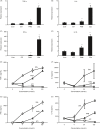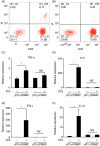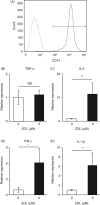Zoledronate promotes inflammatory cytokine expression in human CD14-positive monocytes among peripheral mononuclear cells in the presence of γδ T cells
- PMID: 33131052
- PMCID: PMC7884644
- DOI: 10.1111/imm.13283
Zoledronate promotes inflammatory cytokine expression in human CD14-positive monocytes among peripheral mononuclear cells in the presence of γδ T cells
Abstract
Bisphosphonates distributed to bone exert toxic effects specifically towards osteoclasts. On the other hand, intravenous administration of a nitrogen-containing bisphosphonate (N-BP) such as zoledronate induces acute-phase reactions (APRs), including influenza-like fever 1 day later, indicating an interaction with immunocompetent cells circulating blood. Although it has been reported that activation of γδ T cells is pivotal to induce an APR following treatment with zoledronate, downstream events, including the production of inflammatory cytokines after activation of γδ T cells, remain obscure. We investigated the effects of zoledronate on inflammatory cytokine expression in human peripheral blood mononuclear cells (PBMCs) in vitro. While zoledronate induced mRNA expressions of tumour necrosis factor-α (TNF-α), interleukin (IL)-1β, IL-6 and interferon-γ (IFN-γ) in PBMC, depletion of γδ T cells abolished that zoledronate-induced expression of those cytokines, indicating the necessity of γδ T cells for expression induction by zoledronate. However, which types of cells were responsible for the production of those cytokines in blood remained unclear. As it is generally accepted that monocytes and macrophages are primary sources of inflammatory cytokines, CD14+ cells from PBMC were exposed to zoledronate in the presence of PBMC, which resulted in induced expression of mRNAs for IL-1β, IL-6 and IFN-γ, but not for TNF-α. These results indicate that CD14+ cells are responsible, at least in part, for the production of IL-1β, IL-6 and IFN-γ in blood exposed to zoledronate. This suggests that CD14+ cells play an essential role in the occurrence of APRs following N-BP administration.
Keywords: acute-phase reaction; bisphosphonate; inflammatory cytokines; monocytes; zoledronate; γδ T cells.
© 2020 John Wiley & Sons Ltd.
Figures



Similar articles
-
Activation of Human γδ T Cells: Modulation by Toll-Like Receptor 8 Ligands and Role of Monocytes.Cells. 2020 Mar 13;9(3):713. doi: 10.3390/cells9030713. Cells. 2020. PMID: 32183240 Free PMC article.
-
DC-like cell-dependent activation of human natural killer cells by the bisphosphonate zoledronic acid is regulated by γδ T lymphocytes.Blood. 2011 Sep 8;118(10):2743-51. doi: 10.1182/blood-2011-01-328526. Epub 2011 Jun 14. Blood. 2011. PMID: 21673342
-
Monocytes and γδ T cells control the acute-phase response to intravenous zoledronate: insights from a phase IV safety trial.J Bone Miner Res. 2013 Mar;28(3):464-71. doi: 10.1002/jbmr.1797. J Bone Miner Res. 2013. PMID: 23074158 Clinical Trial.
-
γδ T Cell in Cerebral Ischemic Stroke: Characteristic, Immunity-Inflammatory Role, and Therapy.Front Neurol. 2022 Mar 31;13:842212. doi: 10.3389/fneur.2022.842212. eCollection 2022. Front Neurol. 2022. PMID: 35432162 Free PMC article. Review.
-
Immune and inflammatory mechanisms in hypertension.Nat Rev Cardiol. 2024 Jun;21(6):396-416. doi: 10.1038/s41569-023-00964-1. Epub 2024 Jan 3. Nat Rev Cardiol. 2024. PMID: 38172242 Review.
Cited by
-
Costimulation of γδTCR and TLR7/8 promotes Vδ2 T-cell antitumor activity by modulating mTOR pathway and APC function.J Immunother Cancer. 2021 Dec;9(12):e003339. doi: 10.1136/jitc-2021-003339. J Immunother Cancer. 2021. PMID: 34937742 Free PMC article.
-
Bilateral Knee Effusions Secondary to Zoledronic Acid Infusion.JCEM Case Rep. 2024 Oct 25;2(11):luae199. doi: 10.1210/jcemcr/luae199. eCollection 2024 Nov. JCEM Case Rep. 2024. PMID: 39465231 Free PMC article.
-
PTH treatment before cyclic joint loading improves cartilage health and attenuates load-induced osteoarthritis development in mice.Sci Adv. 2024 Apr 19;10(16):eadk8402. doi: 10.1126/sciadv.adk8402. Epub 2024 Apr 19. Sci Adv. 2024. PMID: 38640238 Free PMC article.
References
-
- Delmas PD. Treatment of postmenopausal osteoporosis. Lancet. 2002;359:2018–26. - PubMed
-
- Neville‐Webbe HL, Holen I, Coleman RE. The anti‐tumour activity of bisphosphonates. Cancer Treat Rev. 2002;28:305–19. - PubMed
-
- Ralston SH, Langston AL, Reid IR. Pathogenesis and management of Paget's disease of bone. Lancet. 2008;372:155–63. - PubMed
-
- Rogers MJ, Gordon S, Benford HL, Coxon FP, Luckman SP, Mönkkönen J, et al. Cellular and molecular mechanisms of action of bisphosphonates. Cancer. 2000;88:2961–78. - PubMed
-
- Russell RGG, Watts NB, Ebetino FH, Rogers MJ. Mechanisms of action of bisphosphonates: similarities and differences and their potential influence on clinical efficacy. Osteoporos Int. 2008;19:733–59. - PubMed
Publication types
MeSH terms
Substances
LinkOut - more resources
Full Text Sources
Research Materials
Miscellaneous

